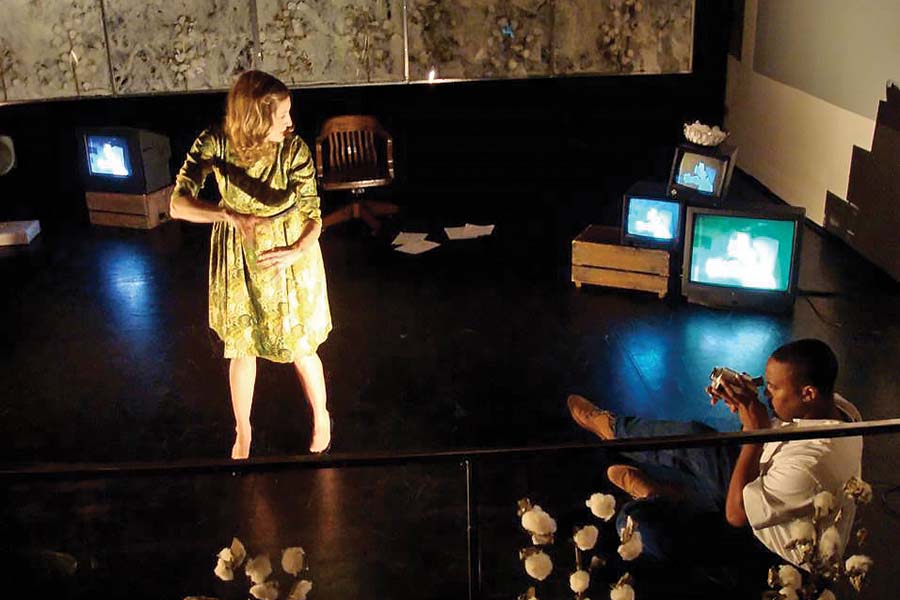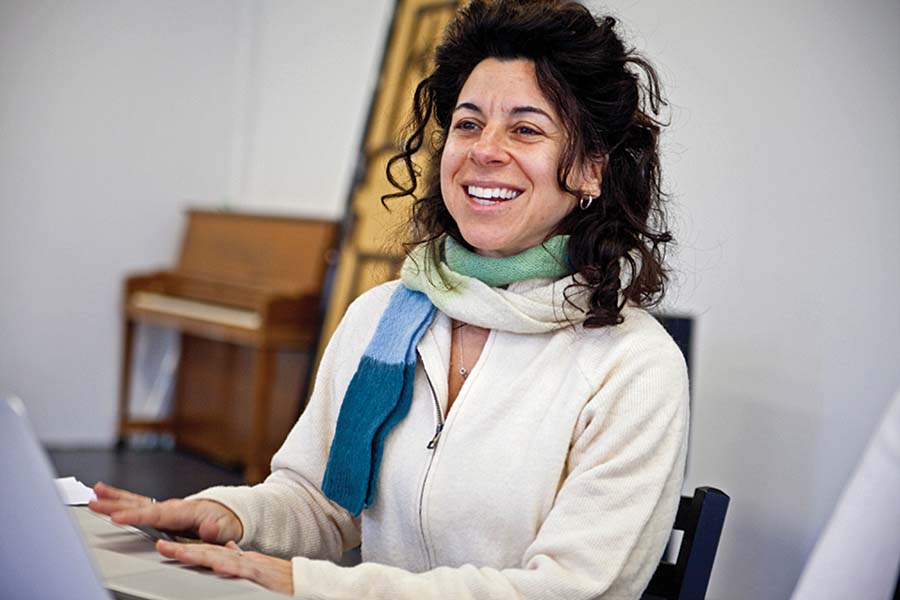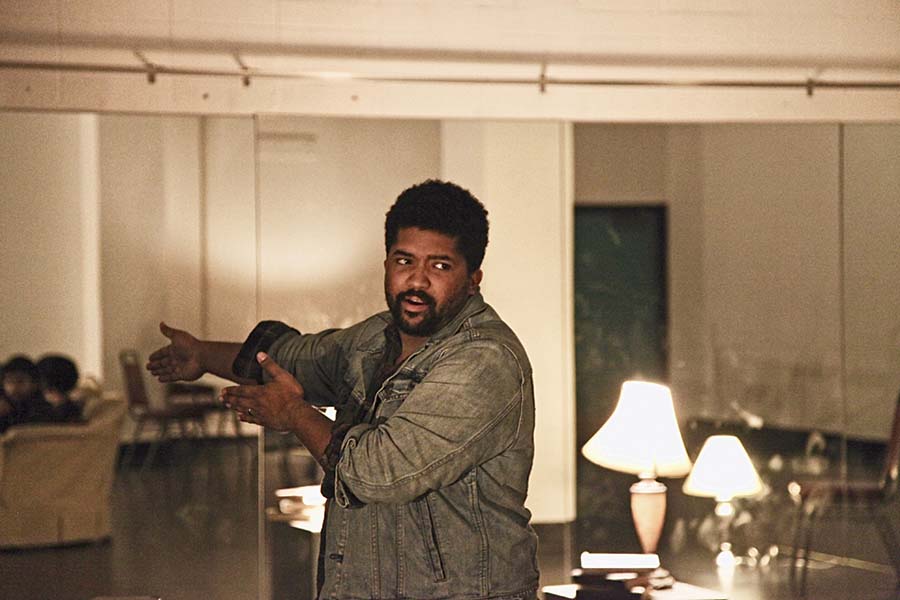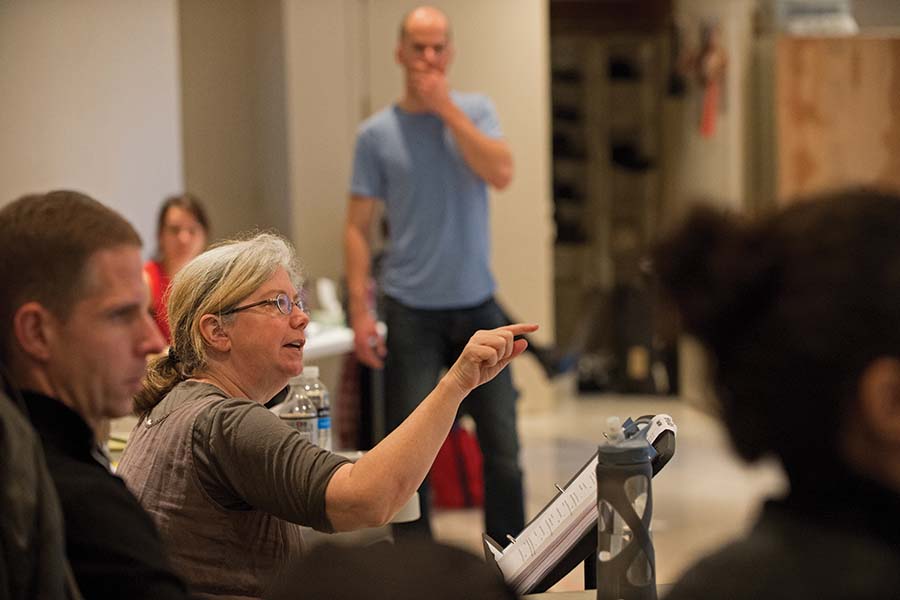A director is someone who chooses a play and directs it. Right?
Not necessarily. A director may be someone who collects a group of actors in a room and throws ideas at them. She may be someone who gets inspired by the physical dimensions of a resonant space. She may be provoked by the exigencies of a pressing social issue. She may be stirred by the poetic language of an ancient text. When one (or many) of these things happens, a play or performance begins to emerge.
Directors who generate their own material in organic ways have long been found on the margins of the theatre world, and their boundary-crossing approaches to making work have expanded traditional notions of the director’s job. These artists—often collaborative, always unpredictable—have also steered attention away from traditional play texts, despite the American theatre’s long-standing valorization of the playwright.
Consider, for example, the influential experimental works of the Wooster Group, the venerable downtown New York troupe, which are developed collaboratively by the company under the guidance of director Elizabeth LeCompte. Like several of her New York colleagues—people like Richard Foreman, who directed his own avant-garde plays starting in the 1960s, and Anne Bogart, whose acclaimed SITI company is known for highly physicalized performances of original and adapted texts—LeCompte skirted the traditional directorial path and made her mark as a generator as well as an interpreter of stage material.
With artists like these as exemplars, the generative-directing trend has been picking up steam in recent years, finding eager practitioners and game audiences all over the country. The concept is also making its way into MFA programs, where a new generation of aspiring directors is being asked to rethink the parameters of what the director’s role can encompass.
Of course, mounting a beautiful, revelatory production of an existing play—whether by Shakespeare, Ibsen, or one of today’s hyper-talented young playwrights—is a skill any burgeoning director still needs to learn. Just as important, according to many contemporary academics and those who study under them, is a willingness to engage in a process of self-discovery, to take leaps into the unknown, to find new ways to make theatre from the void.

“I love living in the world of unexplored ideas, or looking for pathways to explore old ideas,” declares Nataki Garrett, associate artistic director of the Denver Center for Performing Arts Theatre Company, who is also co-director of an L.A.-and-NYC-based ensemble known as Blank the Dog Productions. Garrett’s current Blank the Dog play is The Carolyn Bryant Project, an original piece about the white woman whose accusations got the 14-year-old Emmett Till killed in Mississippi in 1955. The process of creating the work, she says, began with one question: “What does it feel like to be Carolyn Bryant?”
Working with her collaborator, actor Andrea LeBlanc, Garrett built the script slowly out of a series of conversations and improvisational exercises. “We played around inside each idea,” she says, “and when we came across something that was remotely interesting, we scripted it. Then we used it as a jumping-off point to get to something deeper.”
Garrett and LeBlanc also turned to historical records, literary accounts, and documentary films about the Emmett Till case and the Civil Rights Movement. They ended up incorporating some of this material into the script—including the court transcript of the murder trial for the men who attacked Till, only just recovered in 2005. “We couldn’t have written anything better than the court testimony,” Garrett says. “The transcript is theatrical in itself.”
The documentary style of Garrett’s project is in the mold of Elevator Repair Service, the New York-based ensemble acclaimed for its inventive stagings of found texts, including films, novels, and court transcripts. The script for the company’s 2013 play Arguendo, for instance, was taken verbatim from a Supreme Court trial about the rights of erotic dancers. A text is not a requirement, though: One of ERS’s early productions, Marx Brothers on Horseback Salad, was inspired by the Hollywood legend that Salvador Dali had written a screenplay for a Marx Brothers movie; ERS managed to build a show without an extant screenplay (one was uncovered years later).
“We’re trying to find something that we want to throw ourselves into, or at, or against, that we don’t fully understand,” ventures John Collins, ERS’s founding artistic director. Like Garrett, Collins says he’s looking for “a problem to solve, an experiment to conduct. I think what produces this work is not a rigorous repetition of the process so much as a rigorous commitment to a sort of freedom and openness. We try to get ourselves to a place of not knowing. It’s very important that we start out on a project with the capacity to discover that project, not with a preconceived idea of what it will be.”
Elevator Repair Service had its greatest critical success in 2006 with Gatz, a word-for-word enactment of The Great Gatsby in its entirety. Collins says that when the process began, “We just started trying to have an honest encounter with the book and immediately discovered a problem: We didn’t think you could cut this text.” So Collins suggested changing course: “Our plan became to do the entire book—but I made that plan with what I thought was the understanding that it would never work. It was impossible. That idea will fail.
“But my plan to have the idea fail…failed,” Collins says. Thus the seven-hour Gatz was born.
Any director’s generative process is inextricably bound up, of course, with the performers at hand. “Really, my medium is the ensemble,” Collins clarifies, “so even from the beginning, ideas and inspiration about what we might do comes from them. I’ve realized that the business of rehearsing is the business of making mistakes, finding happy accidents, and making discoveries that you can only make while in the midst of attempting something physically.”
Actors are also key elements for Mary Zimmerman, the Chicago-based director who, among other achievements, received a MacArthur “genius” grant in 1998 and won a Tony for best direction in 2002 for her staging of Ovid’s Metamorphoses. Unlike Collins or Garrett, though, who may begin with a question or a problem or an undeveloped idea, Zimmerman almost always starts with a literary text that she adapts for performance. (In addition to Metamorphoses, past projects include The Odyssey, The Arabian Nights, and The Notebooks of Leonardo da Vinci.)
Zimmerman works on the script during rehearsals, inspired in part by her actors. Based on their physicality, their chemistry with each other, and their special talents (can someone do a backflip and sing well?), she adjusts the form and structure of the piece, writing one day ahead of the rehearsal where she will put a scene on its feet.
Known for her vivid stage pictures and evocative use of light and sound, Zimmerman calls the bodies of the actors “one finger of the hand.” The other four fingers are the text, the staging, the scenic elements, and the music.
Zimmerman resists the term “devised,” which is often used to describe generative work, because she thinks her use of literature as a starting point puts her in a slightly different boat. Still, because she adapts and develops work in the moment, she acknowledges that “all the circumstances—the space we’re in, the personal lives of the actors and of myself, what’s happening in the world—impinge in real time on the way the text is inflected.”

As a professor of Performance Studies at Northwestern University, Zimmerman is invested in finding ways to encourage young directors to develop their own work. Teaching this approach presents a unique challenge, since the whole idea is to invent new, as-yet-unexplored forms along the way.
“Last year I decided to try and teach a course that was as closely related to how I actually work as possible,” Zimmerman says. “I called it ‘Staging the Unusual.’” The class was designed to allow the students to find their own texts—a loosely defined starting point—and then to adapt them for performance. One assignment, for example, which Zimmerman called “Epic,” asked the students to choose a news article that included a battle, a catastrophe, or a crowd, and to stage it.
Blank the Dog’s Garrett got her MFA in performance from California Institute of the Arts (and later taught in the acting program there), and she remembers assignments that incorporated a similar enter-the-world-and-make-art-out-of-it approach. In a directing class she took with Travis Preston, now dean of the school of theatre at CalArts, Garrett recalls, “Our first assignment was to find something and then direct it, but the only thing is that it couldn’t be a play—it could be a newspaper article, billboard, clipping, a sign.”
It’s not that Preston was averse to traditional directorial approaches, Garrett notes, but that he took care to grant students wide interpretive freedom. In Garrett’s case, this included directing a deconstructed version of August Wilson’s Fences, complete with the insertion of outside texts and the use of blackface.
Katie Pearl is another director and teacher who believes in giving students a maximum of creative space. Pearl, who has an MFA in writing for performance from Brown University and counts Anne Bogart as a key influence, makes work with her company PearlDamour that is usually site-specific and interactive. The first piece she created with her New Orleans-based collaborator Lisa D’Amour was 1997’s The Grove, set in a grove of trees by the side of the road in Austin, Texas. Composed of a series of shifting tableaux, designed to be viewed by passing cars, the piece lasted a total of 14 hours, and the cast included Austin locals who had responded to an ad in the paper.
Pearl, who spent this past fall teaching in the directing MFA program at UC/San Diego, mentions that her father was a Buddhist psychologist, and, indeed, her teaching seems rooted in a kind of Zen theatre philosophy, stressing openness, awareness, and non-attachment.
“For me, it’s about training students to stay super present and in contact with something that’s happening in the room,” Pearl says. “To come in with an idea of what you want, and then be able to put that aside and see what’s actually there, and be delighted by it, no matter what it is.”
Sometimes a director goes back to school to learn a new way of working. That was the case with Monty Cole, now in the second year of the directing MFA program at CalArts, who had previously had directing success in Chicago, including an acclaimed all-black production of Eugene O’Neill’s The Hairy Ape. What he was craving, he says, was “the ability to generate my own material.”
At CalArts, a first-year class called “Performance by Design” broke students into groups and told them to “make something together,” but no one was assigned traditional acting, directorial, or design roles. “Some people wouldn’t call what was created in that class theatre,” Cole reckons. “So they’re bending the rules of what we think theatre is from Day 1 in the curriculum.”
Cole, together with a collaborator, Breon Arzell, is currently developing a reimagined version of In Dahomey, the 1903 Broadway show that is recorded as the first musical written by and starring African-Americans. Though technically an extant play, In Dahomey is so disjointed, and ran in so many different versions, that Cole and Arzell are essentially rebuilding it, as well as recontextualizing the material by adding current references to black culture.
“It seems like we’re dusting off old bones,” Cole says, “but at the same time, it’s like we’re 3-D printing new bones as well.”
In Dahomey brings to mind some recent metatheatrical Broadway shows, whose directors also had a strong hand in their creation: In 2016, George C. Wolfe directed and wrote a new reconsideration of the 1921 show Shuffle Along; the same year, director Rebecca Taichman spearheaded Indecent, with a script by Paula Vogel, which recounted the production history of God of Vengeance, a 1907 Yiddish drama (and made it to Broadway in 2017). Cole, who plans to mount a production of In Dahomey at CalArts in his final year, may take some hope from the story of Indecent, which started its life as Taichman’s master’s thesis in the directing program at Yale School of Drama.

Finding a certain brand of courage—to face yourself, to face your material, to face the unknown—seems the key ingredient for success at this kind of work. Pearl says that instilling and encouraging fearlessness—an attitude she has trained herself to embrace—is a major goal of her teaching. “I say to my students, ‘Think of this class like a gym, and you’re working out your muscles. Every time you step into a devising process, you can engage the muscles that turn it from something scary and overwhelming into something that is energy-giving and exciting.’ Every show we’ve made has built its own process, just as it’s built its own form.”
ERS’s Collins, who majored in English and theatre as an undergraduate at Yale, never formally studied directing, depending instead on advice from mentors in the New York theatre scene, including LeCompte, Foreman, and David Herskovits of Target Margin Theater, who had also been his professor at Yale. As an experimental director, Collins thinks his lack of formal training may actually be an asset.
“What I took from being around Liz, Richard, David, and others,” Collins notes, “was the importance of having the courage to pursue something that may be difficult or may not make sense—the courage to stick to an impulse.” After a moment he adds, “That—coupled with the ability to be your own toughest critic.”
For Pearl, an equally important exploration is the role of what she calls the artist-citizen. “I had gotten used to thinking of my artist self as separate from my citizen self,” she explains, “but actually those two things can become one in the same. And it can work in both directions—I can make work about issues that I feel strongly about, but I can also bring my artistry into my citizenry.”
That kind of thinking has led PearlDamour to increasingly socially engaged pieces, such as How to Build a Forest (made with New Orleans artist Shawn Hall), in which audience members watched performers slowly build and then dismantle a forest made out of fabric, metal, and found objects; and Milton, which took her and D’Amour into several small American towns—all named Milton—where they collaborated with residents to use performance to help them solve the problems in their communities.
She is in good company with other directors at this fraught political moment, many of whom are thinking about how theatre can act as a form of dissent—or at least civic engagement. Garrett’s Carolyn Bryant, which has been in development for eight years and will be staged as the culmination of the CalArts Center for New Performances season in May, has accompanied its creators through the upsurge of publicity about the deaths of unarmed black people, the birth of the Black Lives Matter movement, the election of Trump, and other cultural shifts, all of which color the piece—and raise the stakes.
“Before, it was easier to yell into a void, because nobody was really listening,” Garrett suggests. “Now we’re yelling alongside a bunch of other voices that are focused on ways to get around white supremacy and cultural inequality.”
Pearl believes it’s no coincidence that such troubled times have sparked fresh interest in generative theatre, especially in a collaborative vein. When the country is so divided, the job of art becomes to ask, in Pearl’s words, “How do we bring people together in conversation? How do we create temporary communities where you can be with someone in a way you might not be otherwise?” She calls the impulse “a yearning toward collectivism.”
Cole sums up the value of making original, generative work even when it’s the harder choice. “To try to make something new—which is the direction that theatre and other mediums are going in—is a lot harder to figure out and to support. But I think it’s totally worth it.”
Pamela Newton is a freelance writer and college writing teacher living in New York City.


